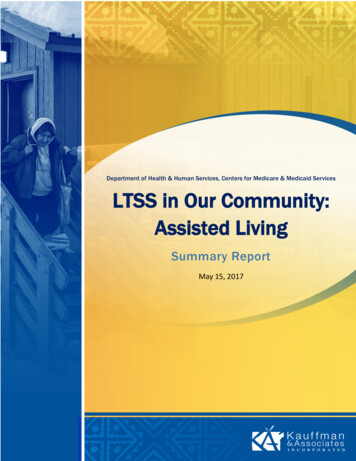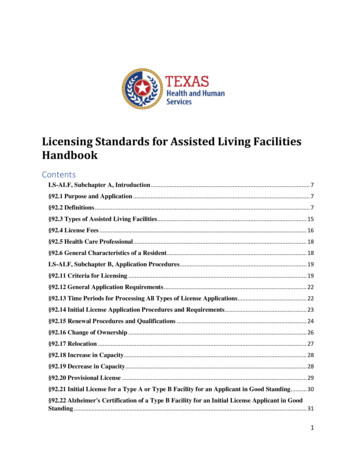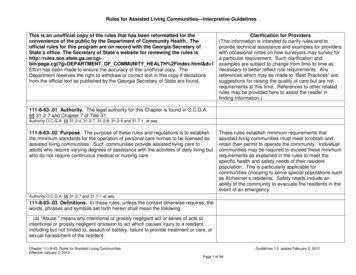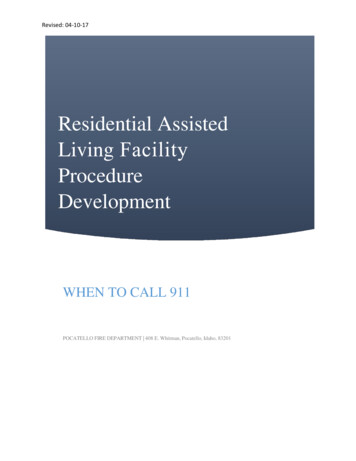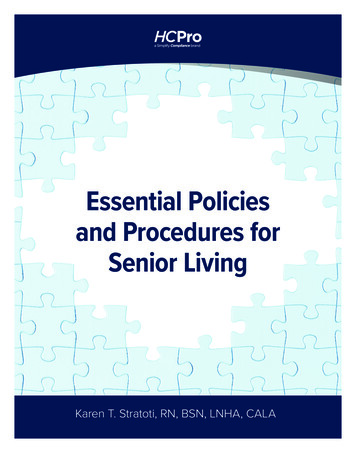
Transcription
CUSTOMER SERVICEIN ASSISTED LIVINGStrategies for BuildingSuccessful PartnershipsKelly Smith Papa, MSN, RN Carol Marshall, MA
CUSTOMER SERVICEIN ASSISTED LIVINGStrategies for Building SuccessfulPartnershipsKelly Smith Papa, RN, BSNCarol Marshall, MA
Customer Service in Assisted Living: Strategies for Building Successful Partnerships is published byHCPro, a division of BLR.Copyright 2016 HCPro, a division of BLRAll rights reserved. Printed in the United States of America. 5 4 3 2 1ISBN: 978-1-68308-199-9No part of this publication may be reproduced, in any form or by any means, without prior writtenconsent of HCPro or the Copyright Clearance Center (978-750-8400). Please notify us immediately if youhave received an unauthorized copy.HCPro provides information resources for the healthcare industry.HCPro is not affiliated in any way with The Joint Commission, which owns the JCAHO and Joint Commission trademarks.Kelly Smith Papa, RN, BSN, AuthorCarol Marshall, MA, AuthorAdrienne Trivers, EditorErin Callahan, Vice President, Product Development & Content StrategyElizabeth Petersen, Executive Vice President, HealthcareMatt Sharpe, Senior Content Production ManagerVincent Skyers, Design Services DirectorVicki McMahan, Sr. Graphic DesignerSheryl Boutin, Layout/Graphic DesignPhilip Couch, Cover DesignerAdvice given is general. Readers should consult professional counsel for specific legal, ethical, or clinicalquestions.Arrangements can be made for quantity discounts. For more information, contact:HCPro100 Winners Circle, Suite 300Brentwood, TN 37027Telephone: 800-650-6787 or 781-639-1872Fax: 800-785-9212Email: customerservice@hcpro.comVisit HCPro online at www.hcpro.com and www.hcmarketplace.com.ii 2016 HCPro
Table of ContentsChapter 1: Why Customer Service Is the Key to Success.1Introduction.1A Brief History of Customer Service.3Why Is Customer Service Important?.5How Customer Service Affects Litigation.8How Consumers Measure Quality Healthcare.9Three Distinctions of Quality.13Reputations Are Earned.16Chapter 2: How to Demonstrate Quality Customer Service.21It Is All About the Relationships.21Pitfalls of the Tour. 26The Tour. 28The True Picture. 30What Do You Need, Hon?. 35Give Customers What They Want.37Chapter 3: Engaging Residents’ Families.43The Impression of the Senior Services Industry. 44New Versus Old. 45Families and Community Reputations. 46Families Are the Frontline Customers.47Interdependency: Staff Depend on the Residents and Their Families.47Staff’s Responsibility for Reputation . 49Ten Strategies for Building Successful Family Partnerships. 53Seven Signs of Families in Conflict. 60Initiate Change. 60Don’t Take It Personally. 62It Is Dangerous to Label Others. 62Broken Promises. 63The Broken Promise and the Family. 65Provide Support and Guidance to Families. 66Keys to Successful Transitions: Putting Your Best Foot Forward. 67A Good Idea to Help New Families. 70Customer Service and the Care Plan. 75Chapter 4: The Upset Family Member.79Seeking to Understand Upset Family Members: From Adversary to Advocate. 79How to Approach the Upset Family. 82 2016 HCProCustomer Service in Assisted Livingiii
The Upset Husband. 89How Staff Can Make a Difference. 92Chapter 5: Train Staff Members to Provide Top-Notch Customer Service.95Introducing S.H.A.R.E. to the Staff. 95Service. 96Honesty. 101Attitude.104Respect.107Ethics.111Advocating for the Resident.113Chapter 6: How to Measure Customer Satisfaction.117The Survey Says .117The Welcome Complaint.123Handling the Complaint. 124Begin the Investigation. 127Find the Solution.128Chapter 7: Engagement.131Engagement as the Root of Customer Service. 131Back to School. 132What’s in a Name?. 132Engagement in Action. 133Iceberg. 133Chapter 8: Caring for Residents Affected by Alzheimer’s Disease and Related Dementia.137Understanding Dementia. 137Programming.138Staff Education .138Chapter 9: Is That the ‘60 Minutes’ Van in the Parking Lot?.139What the News Media Does to Get the Story. 139Crisis Plan. 139Communications. 141Employees.142Ten Steps to Managing a Crisis.142ivCustomer Service in Assisted Living 2016 HCPro
Chapter1Why Customer ServiceIs the Key to SuccessIntroductionThe concept of customer service has become an important facet of assisted living as facilities seek tominimize the risk of litigation and ensure that their occupancy rate is high.In the past, when the elderly became too ill to live alone, families turned to long-term care expertsonly to be frustrated by the lack of services. In recent years, however, there has been an increase inlong-term care services: home health, assisted living, senior apartments, and continuing care retirement communities. Families have a variety of choices to make for the optimal care model for theirloved ones. While price may be the consideration for many, service is the consideration for all.Historically, customer service was something expected at hotels and restaurants. In today’s world,customer service spans every industry. Consumers demand exceptional service with all services,from plumbing to cable installation, or they take their business elsewhere. With the wide use of theInternet, sites have cropped up that expose poor service for every type of company.With the high level of competition for sales in assisted living, exceptional customer service is arequirement for a successful business model. Good customer service not only leads to increased business, a strong reputation, and improved standing in the community, but it also impacts the quality ofcare that an elder receives and the job satisfaction of employees.Exceptional customer service has benefits for the assisted living setting. It:1. Improves or sustains the community’s good reputation2. Increases the community’s resident census3. Decreases the community’s risk for lawsuits4. Increases employee engagement, retention, and satisfaction5. Creates pride in employees6. Welcomes community contributions7. Creates a positive business image8. Motivates medical and other industry professionals to refer patients and families 2016 HCProCustomer Service in Assisted Living1
Chapter 19. Inspires confidence from families10. Establishes the facility as the community of choiceCustomer service is the foundation of all successful businesses. Customers’ freedom of choice—theirability to choose where to conduct their business—is at the core of successful business. When consumers choose to be customers, business prospers.The same holds true for senior living and healthcare consumers. All consumers have a choice aboutwhere they live and receive their healthcare. Consumers often select their physician and choose theirhospital, and in every case they have a choice when choosing an assisted living community.Physicians may be selected by insurance coverage, specialty, or location. But patients judge the quality of a physician’s care by his or her bedside manner. Patients will state “I love my doctor” based onthe way the physician treats them when they interact. The typical patient does not know whether thephysician prescribed the right brand of medication, the right dose, or used the right suture weightwhen closing a wound. However, they do know how they feel when the physician has conversationswith them, answers their questions, and listens to their complaints. It is that relationship that thepatient uses when describing the physician to others. It is the same criteria when residents and families describe the services provided in an assisted living community.The time is rightNow like never before, the concept of providing good customer service is paramount to succeedingin the assisted living industry. Not only is every community vying to maximize occupancy, but withescalating lawsuits and insurance claims, the assisted living industry is taking a hard look at the relationship between the community and the resident and the resident’s family.The old adage “friends don’t sue friends” holds true in today’s litigious long-term care environment.Even egregious acts pass without lawsuits when families feel as though the community had nothingto hide, supported the family during the crisis, and communicated openly.Additionally, satisfied customers spread the good word. It is essential that facilities treat residents,families, and staff with the utmost respect and consideration in an effort to stave off the chance of litigation, an insurance claim, or poor reputation.When community staff form a true partnership with residents and families, the concept of joiningtogether to provide the best possible patient care must become the all-consuming mutual focus. Bycommitting to these goals, the community lays the groundwork for lasting and trusting relationshipsthat may prevent the satisfied customer from seeking legal counsel, complaining to state surveyors, ormoving their loved one to a competing assisted living community.2Customer Service in Assisted Living 2016 HCPro
Why Customer Service Is the Key to SuccessThere couldn’t be a more appropriate time for a book written specifically for assisted living communities that can benefit from developing a customer service program. It is the intention of this programto instill confidence, create trust, and build lasting relationships between community staff and residents. While there is no guarantee that strong relationships will result in successful state surveys, orreduced risk of claims or suits, it is certainly a necessary approach to achieving customer satisfaction,increased occupancy, and improved reputation.Implement this program to initiate a culture change that becomes the lifeblood of the community.For a “customer first” program to work, it must become a way of life for every employee. No matterthe employee’s responsibility or job assignment, the primary job description is “customer first.” Itmust be an ongoing, supported program that starts from the top. Buy-in from the director, managers,and supervisors is critical to the success of the program so that it becomes so well integrated that isbecomes the “personality” of the community. It must be introduced at new-employee orientation andbe part of every aspect of the community’s culture.It simply will not work to instruct staff to conduct themselves in a customer-friendly manner if leaders do not become a role model. Leaders will be most successful when treating staff in the mannerwith which they expect the staff to treat families and residents. Leaders can ensure success by beingthe model of exceptional customer service.A Brief History of Customer ServiceCustomer service, which is also known as “guest relations” or “customer relations,” originated in thehotel industry. As the hotel industry became more competitive, hotels began to look for ways to maketheir establishments more desirable than their competition. How could hotels compete for a limitednumber of guests and ensure that those customers were repeat visitors?Innovative hotels began to focus on the need to make certain every guest was a satisfied customerand offer more “guest-friendly” services than the other businesses in town. Hotels rapidly realizedthat if guests thought they received exceptional value for their dollar, most likely they would returnand, even more important, would share their experiences with others. The easiest and most costeffective way to provide added value was by improving the way guests felt during their stay. Thus,the hotel industry gave birth to the concept of treating customers as guests.Other industries began to model the concept of guest services. For instance, Disneyland , and subsequently Walt Disney World , took the idea of customer service to heart. The Disney “culture” putspark guests at the center of its business. “We create happiness” is Disney’s service theme.Upscale restaurants also jumped onto the customer service bandwagon. If many establishments intown offered good food and elegant surroundings, good customer service could be the one advantage 2016 HCProCustomer Service in Assisted Living3
Chapter 1that would set one restaurant apart from its competitors and bring people back again and again. Afine restaurant will discover quickly that excellent food does not overcome bad service.Healthcare catches onAnother industry that soon took an interest in good customer service was acute care hospitals.Historically, when people became ill or injured or required surgery, they went to the hospital wheretheir doctor sent them, rarely asking questions. In the case of an emergency, patients were rushedto the nearest hospital. Now, with the Centers for Medicare and Medicaid Services Hospital Comparewebsite, consumers can access information about the hospital’s ranking, infection rates, and overall competency. Savvy consumers now select their hospital based on information reported on theInternet. No longer do patients agree to go to the nearest hospital; more likely, they are apt to insistthat the ambulance avoid hospitals with a poor reputation. When physicians began to obtain privileges and offer services at more than one hospital, patients realized they had a choice in healthcaredecisions.Healthcare in the acute hospital setting became a service industry, not too different from serviceindustries such as the hotel industry. Competition for the consumer becomes the focal point of anyindustry that wants to survive in a competitive marketplace. Consider the effects of this in healthcare: Hospitals advertise special services for women in homelike units for maternity care, eliminatesemiprivate rooms in favor of private rooms, decorate with bright colors and plan festive activities inpediatric units, and provide family dining for visitors. All of this creates a competitive edge for thehealthcare dollar.Senior services get on boardThe senior services industry can learn a valuable lesson from the hotel industry: Treat residents asguests. Even though the community is technically their home, living with strangers and being caredfor by strangers, the setting and restricted environment would be greatly improved if all residentswere treated as valuable guests. Competitive nursing homes and assisted living communities areadopting a customer service philosophy based on the following tenets: Customer services has an impact on litigation. If “friends don’t sue friends,” satisfied residentsand family members are less likely to take legal action against a community. Customer service touches every aspect of care. It makes or breaks the reputation of the community. It starts with management and flows through the entire staff. Customer service never ends. Exceptional customer service affects occupancy.4Customer Service in Assisted Living 2016 HCPro
Why Customer Service Is the Key to Success For long-term care, customer service will be reflected on the Five-Star Rating on CMS’ NursingHome Compare website. State surveyors will interview residents and families, and a strong customer service programwill affect the responses to state surveyors. Physicians and care navigators are more or less likely to refer patients. Employees are more likely to remain loyal to the community. Recruitment is positively affected.When residents and families are treated well, offered respect, and allowed to develop trust, residentsbecome satisfied customers. Satisfied customers are more cooperative, are happier, file fewer complaints, refer other potential residents, and become excellent advocates in the community.Why Is Customer Service Important?Every business needs customers to succeed. Customers provide the money so the business canremain in business. Successful companies enjoy continued success because they develop and keepsatisfied customers.Many employees in the assisted living industry believe they are in the “housing with services” business. But that is only partly correct—they are in the people business. Providing housing, care andsafety is the vehicle that brings people together, but assisted living is more than a housing service: Itis the business of serving all the people who enter the community. Those customers include families,companions, delivery people, physicians, therapists, visitors, contractors, and staff.Assisted living communities do not just provide housing and services. Customers expect staff toanswer their questions, solve their problems, and do it cheerfully. Satisfied customers have theirneeds met, but loyal customers see staff exceed their expectations. Assisted living communities mustfocus on giving customers superior service to succeed.Customer loyaltyBusinesses rely on customer loyalty for continued success, so it is important to understand whatkeeps customers satisfied. Staff should answer the following questions:Would you go to your favorite restaurant if the wait staff were rude every time? Would you complain, or just never return? Would you tell your family and friends? Did someone else get service before you, even if he or she came in after you? Have you ever waited too long for your meal to arrive? 2016 HCProCustomer Service in Assisted Living5
Chapter 1Now convert those questions through the eyes of the residents in the community when meals areserved in the dining room:How would you feel if the servers were rude every day, but you had no option but to tolerate their rudebehavior? Would you complain, even if you were afraid of retaliation? Would you tell your family and friends? Did another resident get his or her food before you, even though you were in the diningroom first? Do others at your table get their meal before you? Does your food arrive hot? If not, can you send it back? How long do you have to sit in the dining room before your meal arrives?What was the most outstanding service you ever received at a hotel? Were you there on vacation? Were you there on business? Did hotel staff c
2016 HCPro Customer Service in Assisted Living 1 Introduction The concept of customer service has become an important facet of assisted living as facilities seek to minimize the risk of litigation and ensure that their occupancy rate is high. In the past, when the elderly became too ill
